One Year Later, Vineyard Wind Blade Failure Still Unfolding
Jason Graziadei •

One year ago today, Nantucket residents awoke to reports that green debris was littering the south shore beaches from Madaket out to Tom Nevers. It quickly became clear that the thousands of pieces of fiberglass and foam had floated to the island from the Vineyard Wind farm 15 miles to the southwest following a blade failure.
After failing to notify the town about the incident for 48 hours, Vineyard Wind finally acknowledged the situation following the initial reports of debris washing up and dispatched a team to the island to begin the assessment and cleanup. But in those first few hours, it was the island's lifeguards - some of them just teenagers - who collected the largest and most dangerous pieces of debris from the surf. Despite warnings not to, residents took it upon themselves to gather and dispose of the blade pieces.
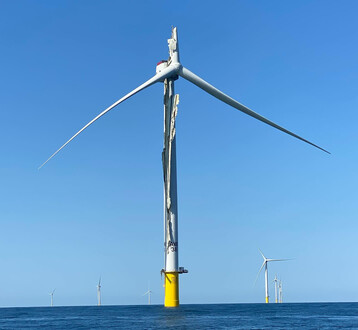
The incident rapidly became a regional and then national news story as the town announced that all of Nantucket's south shore beaches were closed to swimmers "due to large floating debris and sharp fiberglass shards."
Within hours, the federal government agency responsible for monitoring the Vineyard Wind project - the Bureau of Safety and Environmental Enforcement (BSEE) - shut down the multi-billion-dollar project. The story of Vineyard Wind's blade failure and the revelations that followed - including manufacturing deviations and allegations of a safety data falsification scheme at a wind turbine blade plant in Canada - would become the biggest news story of the past year.
Twelve months later, while some parts of the story have concluded, others are still unfolding and remain unresolved.
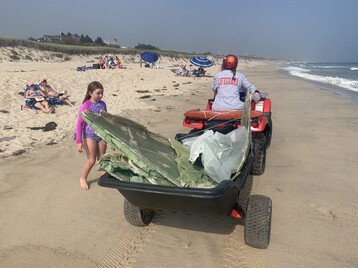
The town of Nantucket just announced a $10.5 million settlement with GE Vernova, the manufacturer of the wind turbine blade that failed, that will compensate island businesses that suffered losses as a result of the blade failure. Although it was not a signatory to the agreement, Vineyard Wind directly benefited from it, as the settlement releases the company from all liability related to the blade failure.
Earlier this year, in the waning days of President Joe Biden's administration, BSEE lifted the suspension order for the project with the condition that GE Vernova and Vineyard Wind remove more than 60 defective blades that were already installed at the wind farm.
The suspension order was lifted despite the fact that BSEE had not completed its long-promised independent investigation into the blade failure and the cause of the incident. Six months after Vineyard Wind was allowed to resume construction, and a full year after the blade failure, BSEE has still not completed the investigation.
"BSEE's comprehensive and independent investigation is ongoing," an agency spokesperson wrote in an email to the Current on Tuesday. "There is no timetable for the completion of the investigation, as BSEE focuses on ensuring that the investigation is thorough and complete."
In September 2024, BSEE ordered Vineyard Wind to complete a study evaluating the "environmental harm" caused by the blade failure. But that study, too, has not yet been completed.
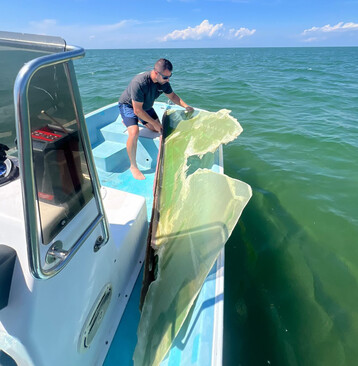
The promised aircraft detection lighting system, or ADLS - which was one of the supposed concessions the town received for signing the Good Neighbor Agreement with Vineyard Wind in 2020 - also remains incomplete. The system will utilize radar to ensure that the lights at the top of each turbine activate only when an aircraft is close to the wind farm area. Currently, dozens of lights blink in unison at the Vineyard Wind farm and are clearly visible from the south shore during the night.
"We are very concerned about Vineyard Wind and the succeeding projects that will bring roughly 1,200 turbines off our shores," said Val Oliver, president of ACK For Whales, the Nantucket-based group that has opposed the Vineyard Wind project since the start, in a statement shared with the Current. "The damage we are seeing from just the first 24 turbines has been devastating. We don’t even know the level of environmental wreckage caused by the blade break last year, for example. The environmental study ordered to be conducted by the Bureau of Safety and Environmental Enforcement has not even begun. The continued and rushed construction is clearly impacting marine life. Fishermen and a marine biologist we are talking to say the area is “dead”. And with the towers lit 24/7 for navigation safety, our dark skies are forever compromised...The Bureau of Safety and Environmental Enforcement has no vessels nor does the Bureau seem to be holding Vineyard Wind accountable for anything, including the document that was to report on the root cause of the blade failure. The developer continues to be allowed to self-regulate with little accountability."
While ACK For Whales and other opponents of Vineyard Wind had hoped the election of Donald Trump as President of the United States in November 2024 would stop the project, construction of the wind farm has continued. In an executive order signed just hours after his inauguration, Trump halted all new federal leases for offshore wind projects and called for a review of existing wind energy leases. That review will focus on "the ecological, economic, and environmental necessity of terminating or amending any existing wind energy leases, identifying any legal bases for such removal."
It's unclear where that review stands today. While Trump's order has indeed halted the progress of offshore wind projects that were still in the permitting stage, including SouthCoast Wind, the construction of projects that had been fully authorized and funded, such as Vineyard Wind and Revolution Wind, has continued.
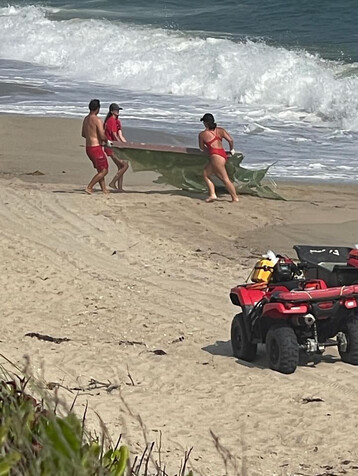
"We are hopeful that President Trump will follow through on his promise to end offshore wind," Oliver said. "We wish things were moving faster in that direction, but perhaps the best way is a careful and thorough process that exposes exactly what offshore wind can and cannot do. Sadly, that conversation never took place before we headed down this unfortunate path."
Vineyard Wind did not respond to a message seeking comment for this story. The offshore wind developer has, in fact, ceased almost all communication with the media, on its website, and social media platforms.
Even the town has not heard from Vineyard Wind since the damaged wind turbine was struck by lightning in February 2025, according to Select Board member Brooke Mohr. At that time, Vineyard Wind once again delayed notifying the town of the lightning strike, which the Select Board called "unacceptable."
The rhetoric from members of the Select Board regarding Vineyard Wind has certainly shifted over the past six months.
“We as a board, and the community at large, even more vehemently, really feel misled by the representations we were given back in 2020," Select Board member Dawn Hill Holdgate said in February. “The visual simulations we were given were not accurate. The promises on the lighting, they have been fully lit for quite a long time now. That never should have happened. The safety and the environmental impacts on the sea life are just far greater than the information we were provided when we were offered a financial settlement based on just the visual impact on our historic landmark, which again is far more impactful than the simulations we were shown."
When the settlement with GE Vernova was announced last week, the Select Board stated: "The Town has found Vineyard Wind wanting in terms of its leadership, accountability, transparency, and stewardship in the aftermath of the blade failure and determined that it would not accept Vineyard Wind as a signatory to the settlement."
Despite that rhetoric, the town remains a signatory to the Good Neighbor Agreement with Vineyard Wind, a deal that has been widely criticized in the community and led to a petition circulated by the group Keep Nantucket Wild urging the Select Board to withdraw from the agreement. More than 2,000 people signed it.
When asked why the town remained in the agreement last week, Mohr spoke about the cost-benefit analysis, but also hinted that there would be more news to come.
"I think you have to look at the cost-benefit analysis of staying in the Good Neighbor Agreement and the assurances that are built into it, versus what we can accomplish through advocacy related to the turbine blade failure," Mohr said. "So that, I think is an important element of this (settlement) agreement (with GE Vernova) is that it allows us to hold Vineyard Wind accountable in the public space for their failures through this entire process, and when we originally entered negotiations, the idea was to do both a financial settlement and maybe a renegotiation of the Good Neighbor agreement, or get Vineyard Wind to be more accountable than they have been, to tighten that up. However, GE Vernova is not a signatory to the Good Neighbor agreement, so we're basically addressing these two things separately. We're dealing with GE Vernova for the financial settlement piece, and there's more to come in terms of how we deal with Vineyard Wind, regarding their actions, or lack of actions, throughout this whole situation...I think how we address our concerns with Vineyard Wind is still very much on the table, and what the best path to do that is - there's more to come. Let me put it that way."
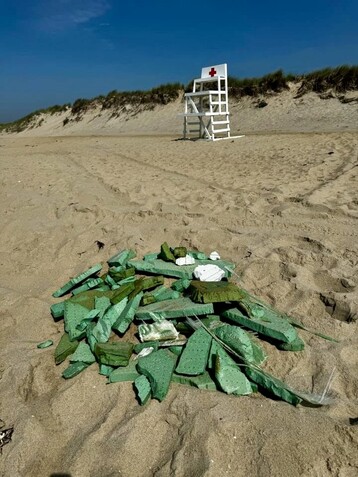
Despite the settlement it is paying, along with the shakeup at its plant in Canada, and its losses related to its offshore wind business, GE Vernova has emerged from the blade failure quite well. The company's stock price is skyrocketing, it is continuing to receive approvals for offshore wind turbines, and the settlement it agreed to pay to Nantucket represents around a hundredth of a percent of the increase to its market cap since the blade collapse.
The company’s stock price has increased by over 212 percent in the year since the July 2024 incident off Nantucket, partly due to the surge in electrical demand anticipated as a result of the artificial intelligence boom. This dramatically outpaces the market, with major composite indexes like the Dow Jones Industrial Average and the NASDAQ only rising about 11 percent in the same period.
GE Vernova’s market capitalization, a standard measure of a company’s value, has also soared, jumping from roughly $50 billion at the time of the collapse to around $150 billion today.
A GE Vernova subsidiary has also just received the green light to test an enormous 902-foot-tall, 18-megawatt offshore wind turbine in Norway. The turbine that suffered the blade failure off the coast of Nantucket was a 13 megawatt turbine, standing at 837 feet, meaning that the Norwegian installation would be a full 65 feet taller, though GE Vernova has indicated that it is pivoting away from and no longer developing the 18 megawatt product.
Iberdrola, the parent company of Avangrid, one of the companies behind Vineyard Wind, has also had a successful year. Its stock price has increased by a little less than a third, and it recently reached a $5.2 billion investment in the British offshore wind farm East Anglia THREE in partnership with the UAE’s Masdar.
JohnCarl McGrady contributed reporting for this story.